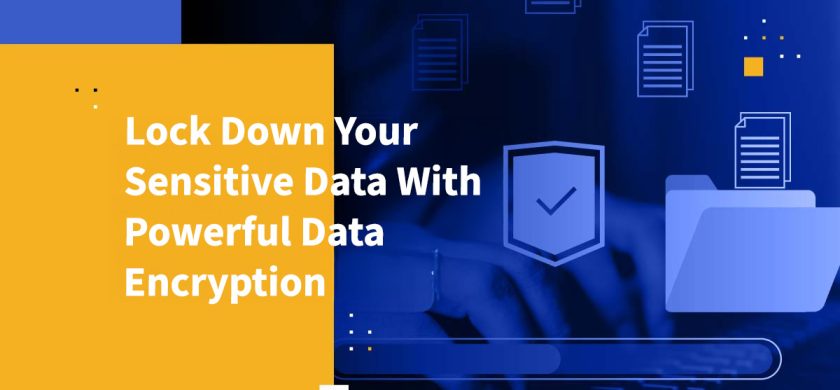
Lock Down Your Sensitive Data With Powerful Data Encryption
If you owned a big, expensive diamond ring, would you leave it on the dashboard in an unlocked car or would you keep it locked in a safe and insure it? If you truly value your valuables, you'll take the necessary precautions to protect them from theft and loss. This same philosophy must apply to your sensitive content like customer records, financial data, and intellectual property. Unless you keep your digital crown jewels completely secure at all times, you only have yourself to blame when they're stolen or leaked. The simplest way to protect your PII, PHI, or IP from unauthorized access is to encrypt it in transit and at rest. Third-party workflow threats have a common theme: a user is the actor, and a file is the agent. Complete protection requires a defense that spans the full breadth of the associated threat surface: the collective paths of all files entering and exiting your organization. A comprehensive defense entails securing, monitoring, and managing all third-party workflows, including secure email, SFTP, and secure file sharing, among others.
In this post, I'll explore the importance of encrypting your sensitive content whenever you store it or share it with trusted third parties.
Your Data May be at Rest, But Attackers Aren't
If your sensitive data is like an expensive diamond ring, then encryption transforms that precious ring into a simple Ring Pop. Jewel thieves will ignore this worthless piece of candy because they're unable to monetize it. You, however, can unlock its true value. Until then, you know it's safe whether you're storing it or sharing it.

When the cost of decrypting stolen or leaked files exceeds the value of the content they contain, you have powerful data encryption. For data storage, AES-256 encryption is a must. In addition, encryption key ownership is mandatory to prevent government agencies from accessing your data without your knowledge. You retain sole ownership of your encryption keys when you store your PII, PHI, and IP in a private cloud. (This is just one of the benefits of a private cloud deployment. My last blog post explores additional benefits.) You must also protect your encryption keys because they're just as valuable as the content they safeguard. Security-first organizations store their encryption keys in an isolated, tamper-proof hardened security module (HSM).
Beware: A File's Journey is Fraught With Danger
Encryption at rest is only half the battle. For most businesses, sending sensitive information outside the organization is unavoidable. At some point, medical staff must share patient records with insurers, in-house counsel must collaborate on contracts with outside counsel, and customers must upload user logs to customer support portals. All of this information is sensitive and all of it is at risk of unauthorized access when it's shared externally. Confidential information is particularly vulnerable when remote employees share it over an unsecured WiFi network, like the ones found at most coffee shops and airport terminals.
If organizations encrypt their communications (the SSL/TLS 1.2 protocol is the standard), a hacker will only see indecipherable code. To ensure complete protection, all communication channels must be encrypted, including web to server, mobile to server, plugin to server, and server to server. Finally, organizations verify email attachment integrity with a unique digital fingerprint on their email communications. Encrypting your content in transit and at rest is a critical step in protecting your digital crown jewels. There are, however, additional strategies you can employ to harden the threat surface of your third-party workflows. In my next blog post, I'll explore metadata and the value it provides. This unique intelligence strengthens your organization's security and governance over the flow of information into and out of your organization.
To learn more about how to build a holistic defense of the third-party workflow threat surface, schedule a custom demo of Kiteworks.
Frequently Asked Questions
Managed file transfer (MFT) is a software system that helps organizations securely exchange large volumes of information. It enables an end-to-end data transfer process that supports the secure transfer of data between different systems and networks. MFT offers multiple features such as encryption, automation, and auditing to ensure secure transfer of data. It also provides features to monitor, track, and control the transmission of sensitive data.
Managed file transfer (MFT) offers businesses several advantages over other forms of file transfer. These advantages include: increased security such as encryption and authentication; automation that saves time and money by streamlining processes; centralized management to maintain visibility and control over file transfers from a centralized platform; comprehensive auditing that provides an audit trail of all user activities; improved scalability so organizations can easily increase their file transfer capacity and throughput, enabling them to accommodate greater amounts of file transfers and data.
MFT platforms use a variety of security measures to protect data, including secure protocols, encryption, and authentication. In addition, access control is often used to ensure that only authorized users can access the data. Depending on the platform, additional features like audit tracking, monitoring and alerting, and automated workflows may also be available.
Yes, many managed file transfer platforms are designed to be compatible with existing systems and infrastructure. Depending on the platform and your specific requirements, MFT can be used to securely transfer data between systems, or to integrate with existing workflows and processes.
Additional Resources
- Blog Post secure file share service
- Blog Post HIPAA Encryption
- Blog Post file sharing business
- Glossary Everything You Need to Know About AES-Encryption
- Blog Post secure file sharing law firms
- Blog Post SFTP Security – Is It Truly Secure? –
- Blog Post best secure file sharing
- Blog Post hipaa encryption requirements for electronic patient health information
- Blog Post hipaa-compliant cloud storage subscribe popular posts
- Blog Post how does data compliance impact

